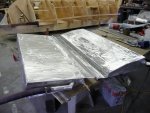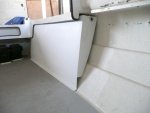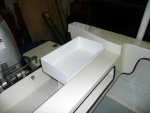marco422
New member
- Joined
- Sep 25, 2008
- Messages
- 103
- Reaction score
- 0
- C Dory Year
- 2007
- C Dory Model
- 16 Cruiser
- Vessel Name
- Gaiasika
In the quest for a 375 km range (200 nm) for extended adventures and less weight astern, I am researching a pair of saddle tanks for my 16 Cruiser. None of the Moeller tanks fit so I am thinking of having aluminum tanks made with dimensions of about 56"L x 6"W (bot)/8"W (top) x 12"H. to hold about 65 litres (17 gal) each. They would extend from the seat compartments to just short of the transom underneath. I am planning a sending unit, vent to the side of the splashwell, and pickup in each tank to a dual valve under the aft storage compartment. I was thinking of "above-deck" style fill covers installed just in front of the aft storage compartment.
Can anyone give me any advice about this project? Might I be better off installing regular fill plates in the splashwell sides or would this cause problems in case of a spill? I suppose I could use transom plugs in the splashwell drains while refueling in case of a spill since it's probably better to spill in the splashwell and mop up rather than inside the cockpit. That would have the advantage of keeping the tank tops inside the cockpit clear so there is a nice step/seat on each side. I know for some this would interfere with fishing, but I never fish and generally use the boat for long-distance explorations.
Should I incorporate interior baffles in the tank, since they are so long? What is a good outside coating for the tanks; or is that not recommended?
Are there any recommended fabricators or can I get a marine metal shop to weld them up? Or is the project going to be totally cost-prohibitive?
Can anyone give me any advice about this project? Might I be better off installing regular fill plates in the splashwell sides or would this cause problems in case of a spill? I suppose I could use transom plugs in the splashwell drains while refueling in case of a spill since it's probably better to spill in the splashwell and mop up rather than inside the cockpit. That would have the advantage of keeping the tank tops inside the cockpit clear so there is a nice step/seat on each side. I know for some this would interfere with fishing, but I never fish and generally use the boat for long-distance explorations.
Should I incorporate interior baffles in the tank, since they are so long? What is a good outside coating for the tanks; or is that not recommended?
Are there any recommended fabricators or can I get a marine metal shop to weld them up? Or is the project going to be totally cost-prohibitive?





